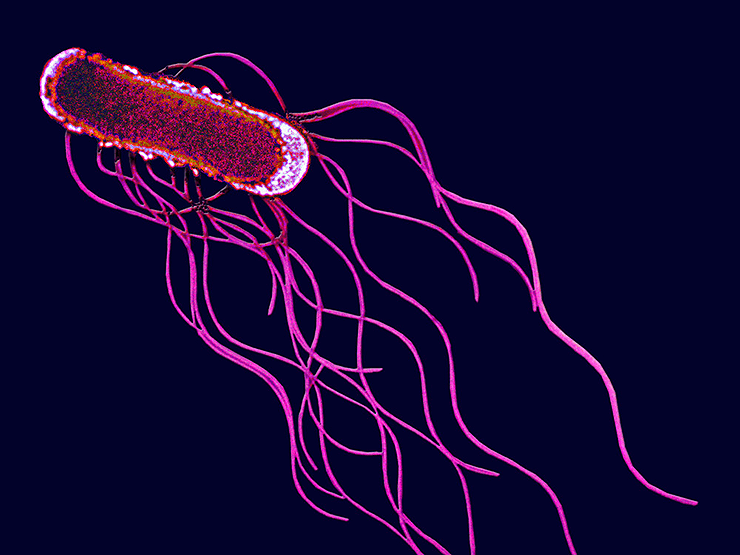

Salmonella was discovered in the XIX century and was named after an American veterinarian Daniel Elmer Salmon who discovered it. Salmonella is divided into six subspecies, and salmonella enterica is one of them. Salmonella enterica is a bacterium of the genus Salmonella. As a rule, it is contained in raw food, specifically in hen or geese eggs, or other food that contains them as ingredients if the preparation procedures were violated. Salmonella enterica has a shape of flagellate, rod-shaped, a Gram-negative, a facultative anaerobic bacterium (Salmonella enterica). Salmonella enterica does not have any specific areas of distribution and is common to all parts of the planet.
Internal and External Structures
Salmonella enterica does not have a shaped nucleus, and its DNA is preserved in an unclearly structured nucleoid. The bacterium also has such organelles as ribosomes, cellular fluid, and other ones that are responsible for storing energy and protein (Cui et al.). When it comes to the external structure of Salmonella enterica, it is necessary to state that it has such organelles as flagella and sensory organelles. Flagella are used for moving, and sensory organelles help the bacterium measure the temperature and the chemical nature of the extracellular space (Salmonella enterica). Salmonella enterica can form strong binds to host organisms and their cells because it contains a lot of fimbrial and non-fimbrial adhesins that ensure stable and almost unbreakable binding.
Oxygen and Temperature Needs
Salmonella enterica pertains to the group of anaerobic bacteria, which means that it does not need oxygen to live and develop. Moreover, they are unable to grow in the presence of oxygen (Cui et al.). Salmonella enterica can survive after drying and may live in dry places and food for years. This group of bacteria cannot be destroyed by freezing, but ultraviolet radiation boosts the process of their destruction. Salmonella enterica dies after being heated to 55-60 °C for ninety minutes or more. To protect from salmonellosis, doctors and scientists recommend heating and boiling food to at least 75 °C.
Infection and Its Symptoms

The disease caused by salmonella enteric and other types of bacteria of the group is called salmonellosis. It is dangerous since if not properly treated, the infection may boost the risk of the development of colorectal cancer (Silbergleit et al., 136). The most common characteristics of the disease are:
- spasmodic pains in the stomach,
- vomiting,
- diarrhea.
As a rule, they appear after 12-72 hours after being infected. As a rule, the majority of patients with salmonellosis recover in four days or a week as maximum, but in case of severe diarrhea, the patient may need hospitalization.
Prevention
There are no specific preventive measures for this infection for every person because it is impossible to visually or by other characteristics to establish whether food or water contains the bacteria. In the case of salmonellosis prevention, it is a matter of sanitary and epidemiologic service concern. It needs to liquidate the infection in animals, control farms and their products, as well the quality of tap water. For general citizens, it is necessary to follow the rules of storing food products and to be attentive and careful during the process of its preparation. Apart from that, people should pay attention to personal hygiene and the hygiene of the house since salmonella enterica may be contained not only in food but in tap water as well.
Works Cited
Cui, Luqing et al. “Virulence Comparison of Salmonella enterica Subsp. enterica Isolates from Chicken and Whole Genome Analysis of the High Virulent Strain S. Enteritidis 211”. Microorganisms, vol. 9, no. 11, 2021.
“Salmonella Enterica”, Microchem Laboratory, n.d. Web.
Silbergleit, Matthew et al. “Chapter Five – Oral and Intestinal Bacterial Exotoxins: Potential Linked to Carcinogenesis.” Progress in Molecular Biology and Translational Science, vol. 171, 2020, pp. 121-193. Web.